FEATURE ARTICLE
The following feature articles appear in detail in the publication.
SKILLS SHORTAGES IN WESTERN AUSTRALIA - PART 1
This article is the first part of an analysis of skills shortages in Western Australia. It will examine the indicators of skills shortages in Western Australia and explore the nature of the recent shortage, by determining whether the shortage is a skills or labour shortage, identifying where the problem is most concentrated in terms of occupations and related industries, and investigating whether the issue is cyclical (due to an insufficient supply of labour) or structural (due to a mismatch of skills).
STATE ACCOUNTS - A SNAPSHOT OF WESTERN AUSTRALIA'S ECONOMY IN 2004-05
This article reports on the growth of the Western Australian economy in 2004-05, using the measures of Gross State Product, Gross State Product per capita and Real Gross State Income, and compares its performance with other states and territories. It also analyses the components of the economy that have driven growth in 2004-05 such as household consumption, business investment, government spending and net exports, as well as identifying the industries that have contributed most to economic growth, using the measure of Total Factor Income.
OVERVIEW
ECONOMIC SUMMARY
Western Australia's domestic economy continued to grow at a steady pace in the September quarter 2005, with State Final Demand (trend chain volume terms) increasing by 1.4%, slightly down on the 1.6% rise in the previous quarter. The September quarter result was higher than the 0.8% increase in Australia's Domestic Final Demand. Growth in the state economy was driven by Business investment, up $725 million (17.8%) in the September quarter, in seasonally adjusted terms. Detracting from Western Australia's growth in State Final Demand was Government sector investment, mainly from State and local public corporations (down $205 million or 39.2%) and General state and local government (down $123 million or 24.1%).
The value of exports from Western Australia continued to grow strongly through the year to September quarter 2005, increasing by $2,013 million (22.2%). The main driver of growth was Iron ore exports, rising in value by $1,247 million (73.4%), aided by both price and volume increases. Natural gas (up $282 million or 40.2%) and Crude petroleum oils (up $272 million or 21.6%) also made significant contributions to the state's exports growth over the period. The greater than expected growth in the US and Chinese economies over recent quarters, as well as the strengthening Japanese economy, provide a positive outlook for Western Australian exports in 2006. The value of imports to Western Australia have also grown substantially between the September quarters of 2004 and 2005, rising by $429 million (12.9%), mainly in Refined petroleum oils and Non-monetary gold.
Employment growth weakened in Western Australia in the three months to November 2005, with the trend estimate of employed persons rising by 0.3%, compared to the 1.0% increase over the previous three month period. The decline in Western Australia's employment growth was driven by a 0.6% fall in full-time employment. The industries showing the largest growth in employment were Manufacturing (up 7,581 or 8.5%) and Mining (up 5,065 or 10.6%). Unemployment fell dramatically in the state in the three months to November 2005, with the number of unemployed persons decreasing by 10.8%, following an 8.0% fall in the previous three month period. The sharp and persistent decline in unemployed persons since mid-2005 has driven the state's unemployment rate to 3.9% in November 2005, its lowest level since the current series began in 1978.
STATE ACCOUNTS
State Final Demand
Growth in Western Australia's domestic economy has been relatively steady since the December quarter 2003, with State Final Demand (trend chain volume terms) growing between the narrow bounds of 1.3% (March quarter 2004) and 1.8% (September quarter 2004) over the eight quarters to September 2005. State Final Demand in Western Australia rose by 1.4% in the September quarter 2005, down slightly on the 1.6% increase in the previous quarter. The September quarter result was higher than the 0.8% increase in Australia's Domestic Final Demand and ranked equal second (with Queensland) behind the growth recorded in the Northern Territory of 1.7%.
STATE FINAL DEMAND, Chain volume measures - Change from previous quarter
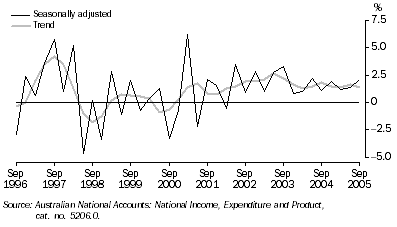
In seasonally adjusted terms, Western Australia's chain volume measure of State Final Demand rose by 2.1% in the September quarter 2005, mainly driven by Business investment (up $725 million or 17.8%). Strong growth was recorded in investment on New machinery and equipment and New engineering construction, supported by the expansion of the state's Mining industry, including work on the fifth LNG train of the North West Shelf Project and the Enfield oil field development. Mining-related activities of the Property and business services industry, such as surveying, consultant engineering and equipment leasing, also recorded strong investment growth during the quarter. Other notable contributions to September quarter growth were Dwelling investment (up $102 million or 7.4%) and Household final consumption expenditure (up $92 million or 0.8%), mainly on Food and Rent and other dwelling services. Despite the significant contribution of household consumption to the state economy, its rate of growth almost halved from the previous quarter, mainly due to a decline in fuel consumption as a result of rising fuel prices.
Detracting from Western Australia's growth in State Final Demand (seasonally adjusted chain volume terms) in the September quarter 2005 was Government sector expenditure. Investment by State and local public corporations fell by $205 million (39.2%) and investment by General state and local government was down by $123 million (24.1%). Final consumption expenditure by State and local government also fell by $52 million (2.2%) in the quarter. The decline in government spending, however, comes after a strong period of growth in State and local government expenditure in the June quarter 2005.
PRICES
Consumer Price Index
The Consumer Price Index (CPI) for Perth rose by 1.0% in the September quarter 2005, following an increase of 1.3% in the previous quarter. Nationally, the CPI rose by 0.9% in the September quarter. The major contributors to Perth's CPI growth were Automotive fuel (up 12.8%) and House purchase (up 3.6%). Petrol prices continued to rise following the trend in global crude oil prices, while the ongoing strength of housing demand in Perth drove up the purchase price of housing. Other notable contributions to Perth's CPI growth were Vegetables (up 6.4%), Domestic holiday travel and accommodation (up 2.8%) and Property rates and charges (up 5.1%).
CONSUMER PRICE INDEX (ALL GROUPS), Change from same quarter previous year
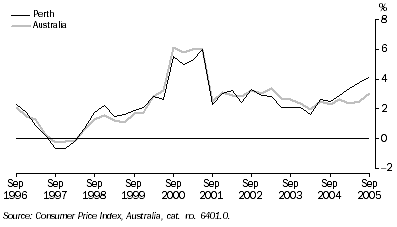
Across Australia's capital cities, Perth recorded the largest increase in prices through the year to September quarter 2005. Perth's CPI rose by 4.1%, well above the national increase of 3.0%. The higher result for Perth was largely attributable to Housing, which rose by 8.9%, more than twice the national average (up 3.9%). Australia's CPI increase of 3.0% over the year was at the top of the Reserve Bank of Australia's (RBA) target range for inflation. Despite this result, the RBA has played down any immediate need for a tightening of monetary policy, as it expects underlying prices to increase only gradually over the year ahead. It identified the main inflationary pressures as rising import prices and higher business costs such as wages, fuel and commodities.
Wage Price Index
A slight deceleration in growth in Western Australia's Wage Price Index (WPI) indicates that wage pressures may be easing in the state. Growth in the state's quarterly index of total hourly rates of pay (excluding bonuses) rose by 4.9% through the year to September quarter 2005, slightly lower than the 5.0% increase in the year to June quarter 2005. However, the rise of 4.9% in the current period was above the national increase of 4.2% and was the largest increase of all states and territories.
Wage price index, Change from same quarter previous year
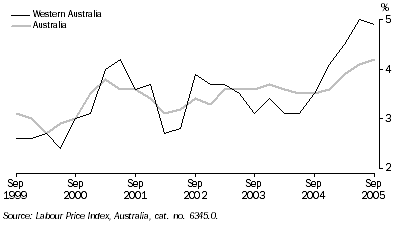
The higher result for Western Australia reflects the relative strength of economic activity, and associated labour demand, in the state's resources, construction and housing sectors. Construction (up 14.9%) and Mining (up 5.5%) recorded the highest annual wages growth in the state, driven by the strong demand for skilled labour in these rapidly expanding industries. The occupations showing the highest annual wages growth in Western Australia were Labourers and related workers (up 8.0%), Tradespersons and related workers (up 7.5%) and Managers and administrators (up 5.4%).
CONSUMPTION
Retail trade
Retail turnover (trend) rose by 1.8% (or $93 million) in Western Australia in the three months to October 2005, compared to the previous three month period. Nationally, retail turnover increased by 1.0%. Growth in Western Australia's retail turnover has decelerated in the last five months, from 1.0% in May 2005 to 0.3% in October 2005. This downward trend in growth has coincided with falling consumer sentiment in the state throughout 2005, as a result of weaker than expected economic data, the increase in official interest rates in March 2005 (up 0.25% to 5.50%), and rising petrol prices.
Monthly retail turnover, Current prices
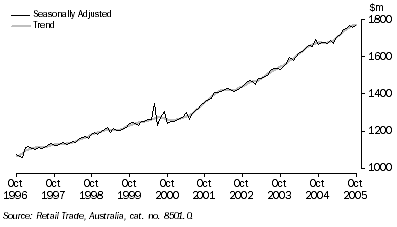
Growth in turnover was evident across all sectors of Western Australia's retail industry in the three months to October 2005 (compared to the three months to July 2005), with the exception of Other retailing (down 6.1% or $29 million). Growth was highest in Food retailing, which increased by 3.8% (or $85 million) over the period, followed by growth in Household good retailing, up 2.3% (or $21 million), reflecting the renewed strength of the state's housing market.
New motor vehicle sales
The trend estimate for sales of new motor vehicles in Western Australia increased for the twenty-fourth consecutive month in November 2005, rising by 1.1% to 8,937 vehicles. Growth in new motor vehicle sales have, however, moderated over the last three months, from 2.0% in August 2005 to 1.1% in November 2005.
New motor vehicle sales
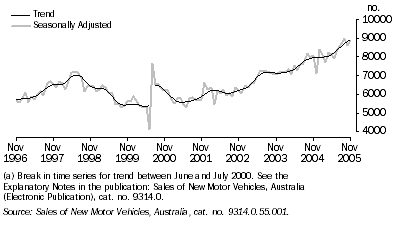
In the three months to November 2005, sales of new motor vehicles (trend) rose by 4.9% (1,250 vehicles) in Western Australia, compared to the previous three month period. In contrast, new motor vehicle sales fell by 1.0% nationally. Driving the state increase were sales of Passenger vehicles, up 712 vehicles (4.8%), while Sports utility vehicles (up 279 vehicles or 5.7%) and Other vehicles (up 259 vehicles or 4.5%) also recorded strong sales growth over the period.
INVESTMENT AND FINANCE
Private new capital expenditure
Business investment (trend chain volume terms) increased by 5.1% ($137 million) in Western Australia in the September quarter 2005, following increases of 6.3% and 5.5% in the previous two quarters. Between the June and September quarters of 2005 investment growth eased slightly for Buildings and structures, down from 6.6% ($81 million) to 4.0% ($52 million); and Equipment, plant and machinery, down from 6.0% ($78 million) to 4.9% ($67 million). Despite the deceleration, the level of business investment in Western Australia was at a record high level in the September quarter 2005 ($2,821 million), with investment in Equipment, plant and machinery ($1,440 million) and Buildings and structures ($1,365 million) contributing almost equally to the total.
PRIVATE NEW CAPITAL EXPENDITURE, Chain volume measures
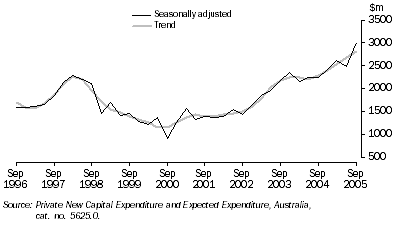
In original current price terms, business investment rose by 37.7% ($856 million) in Western Australia through the year to September quarter 2005. Growth was recorded across all broad industry groups, including Mining (up $408 million or 30.2%), Manufacturing (up $260 million or 112.1%) and Other selected industries (up $188 million or 27.2%). The investment activity in Mining ($1.8 billion) and Manufacturing ($492 million) were at their highest levels on record in the September quarter. Much of the growth in business investment over the year can be attributed to the expansion of the state's resources sector, including activities of mining, downstream mineral processing and mining-related business services such as surveying, consultant engineering and equipment leasing.
Housing finance commitments
The number of housing finance commitments for owner occupation (trend) in Western Australia increased by 4.4% (1,033) in the three months to October 2005, compared to the previous three month period, and above the 2.7% rise nationally. The state's housing finance commitments reached their highest level on record at 8,360 in October 2005. The rise in housing finance (original) was mainly driven by non-first home buyers, up 424 commitments (2.1%) over the last three months (compared to the previous three months), with first home buyers recording a smaller increase of 352 commitments (8.5%).
Housing finance commitments, Number of dwellings financed
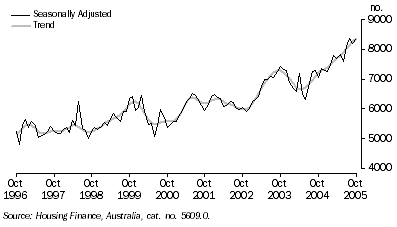
The total value of housing finance commitments for owner occupation (trend) increased by 8.0% ($340 million) in Western Australia in the three months to October 2005, compared to the previous three months - almost double the national rise of 4.2%. The state increase was mainly driven by finance commitments for the purchase of established dwellings, up $221 million (8.1%) in original terms. The value of housing finance for the construction of new dwellings (original) also rose during the period, up 3.5% ($23 million), driven by both owner occupiers (up $12 million or 2.1%) and investors (up $11 million or 15.3%). The rise of 3.5% in the last three months was significantly lower than the 12.4% increase recorded in the previous three month period, indicating that the growth in housing construction activity may begin to moderate in the latter half of 2006, after the recent rise in new house approvals and housing work in the pipeline reaches completion.
CONSTRUCTION
Building approvals
In the three months to October 2005, the number of houses approved for construction (trend) increased by 5.7% (287 approvals) in Western Australia, compared to the previous three months. Nationally, the number of house approvals fell by 3.2% over the same period. The number of house approvals in Western Australia rose in each month since June 2005 to reach 1,817 approvals in October 2005 - the highest level since October 1988. The resurgence in house approvals since mid-2005 suggests construction activity in the state's housing sector should continue to grow into early 2006.
NUMBER OF DWELLINGS APPROVED, Houses: Trend
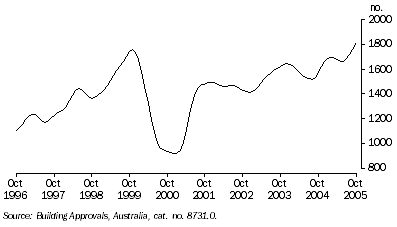
In current price terms, the value of new houses approved (trend) in Western Australia rose by 8.5% ($83 million) in the three months to October 2005, from the previous three month period. In contrast, the value of new house approvals declined by 7.1% nationally. Growth in the value of new house approvals in Western Australia, coupled with an increase in the value of new house construction activity yet to be done at the end of the June quarter 2005 (up 6.0% to $1,331 million), further supports growth in house construction activity into the first half of 2006.
TRADE
The value of Western Australia's trade surplus rose by 27.6% between the September quarters of 2004 and 2005, reaching $7,315 million. The increase was driven by strong exports growth, up $2,013 million, reflecting the rapid rise in commodity prices and increased volumes following production capacity expansions in the state's resources sector. Imports also grew over the period (up $429 million), supported by a higher terms of trade, a strong domestic currency and high levels of consumer and business confidence.
VALUE OF WESTERN AUSTRALIA'S TRADE SURPLUS, Change from same quarter previous year
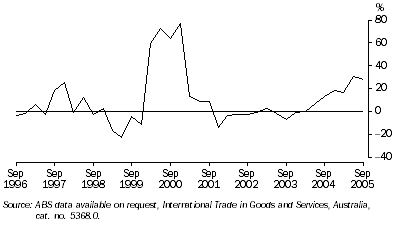
Western Australia's trade surplus with China increased by $807 million (74.1%) to $1,896 million between the September quarters of 2004 and 2005, largely driven by Iron ore exports. The state's trade position with Japan also improved considerably, with the surplus increasing by $543 million (32.1%) to $2,236 million. The trade surplus with India grew by $529 million (122.8%) over the year to $961 million, with Non-monetary gold exports accounting for $911 million (94.8%) of the surplus. A fall in Western Australia's Gold exports to the United Kingdom saw the state record a trade deficit of $38 million with that country, after recording a $670 million surplus in the September quarter 2004. The state's largest quarterly trade deficit, with the United States, rose by $66 million (53.8%) to $188.9 million over the period.
Exports
The value of Western Australia's exports rose by 22.2% to $11,069 million in the September quarter 2005, compared to the same period of 2004 - the highest value recorded since the quarterly series began in March 1988. Iron ore exports were the main contributor to growth, increasing by $1,247 million (73.4%), aided by a 71.5% price rise negotiated with Japanese steel mills (taking effect in April 2005) and higher export volumes (up 7.6%) over the period. The value of Crude petroleum oil exports increased by $272 million (21.6%) due to strong price growth, while the value of exports of Natural gas rose by $282 million (40.2%) coinciding with the commissioning of the fourth LNG train on the North West Shelf in December. Detracting from growth over the period were exports of Wheat, which fell by $175 million (31.4%) through the year to September quarter 2005, largely due to a 23.3% decline in the volume exported.
Imports
The value of imports to Western Australia rose by 12.9% to $3,755 million in the September quarter 2005, compared to the same period of 2005. Much of the growth in imports was driven by rising levels of investment activity, primarily within the state's resources sector and high levels of consumer and business sentiment in the state. The main commodities contributing to the rise in the state's imports were: Refined petroleum oils, up $159 million (91.9%) - reflecting both price and volume increases; Non-monetary gold, up $148 million (29.9%) and Confidential items, up $67 million (79.2%).
MINING
Mineral and petroleum exploration expenditure
Mineral exploration expenditure (trend) in Western Australia fell slightly, down 0.6% ($1 million) in the September quarter 2005, having increased for the previous fourteen quarters - the longest period of growth since the quarterly series began in 1988. Strong global demand for raw materials and high commodity prices have continued to drive expenditure on mineral exploration in the state.
Mineral exploration expenditure, Total minerals
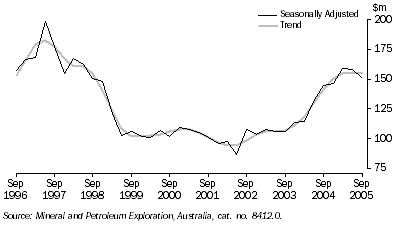
Western Australia's mineral exploration expenditure (original) rose by 4.4% ($7 million) through the year to September quarter 2005. The main contributors to growth over the period were exploration expenditure on Nickel and cobalt (up 27.2 % or $8 million) and on Iron ore (up 21.3% or $6 million). Detracting from growth was a 16.1% ($12 million) fall in expenditure on Gold exploration.
Petroleum exploration expenditure (original) in Western Australia rose by 4.2% ($5 million) through the year to September quarter 2005. The rapid rise in petroleum prices over the period, together with the susceptibility of global oil supplies to unexpected events, have stimulated exploration expenditure in the state.
Mineral and energy production
Western Australia recorded production increases in most major mineral and energy resources in the September quarter 2005, compared to the corresponding quarter of 2004. The largest growth was recorded in the production of Zinc, which increased by 38.5% in response to rising world prices. Production of Diamonds rose by 13.3%, mainly due to production at the Argyle mine recovering from tight mining conditions in 2004. Gold (down 2.3%) and Electricity generated (down 2.2%) were the only major commodities to record production decreases over the year.
TOURISM
Short-term arrivals on holiday
A total of 52,913 overseas visitors arrived in Western Australia by air on holiday in the three months to September 2005, an increase of 5,274 (11.1%) on the same period of 2004. Visitors arrivals rose from most selected countries with Singapore (up 2,757 or 44.8%), the United Kingdom and Ireland (up 912 or 10.7%) and Europe (up 465 or 6.7%) recording the largest increases. The only falls recorded were in arrivals from Thailand (down 164 or 13.6%) and Japan (down 134 or 1.5%).
SHORT-TERM VISITOR ARRIVALS AND RESIDENT DEPARTURES OVERSEAS, By air on holiday
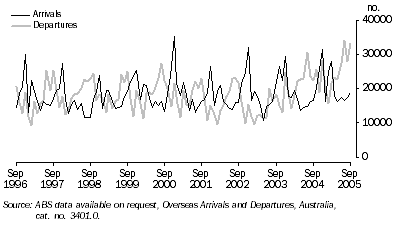
Short-term departures on holiday
The number of Western Australian residents departing by air on holiday increased to 95,069 in the three months to September 2005, 18,622 (24.4%) more than in the same period of 2004. Increases in resident departures were recorded to most of the selected destinations, with the largest being departures to Indonesia (up 6,038 or 23.6%), Singapore (up 3,142 or 56.5%) and Malaysia (up 1,708 or 41.5%). Thailand (down 79 or 1.0%) recorded the only decrease in short-term resident departures from Western Australia over the period.
LABOUR MARKET
Employment
Employment growth weakened in Western Australia in the three months to November 2005, with the trend estimate of employed persons rising by 0.3%, compared to the 1.0% increase over the previous three month period. Nationally, employment remained relatively unchanged over the three months to November. The decline in Western Australia's employment growth was driven by a 0.6% fall in full-time employment, entirely in full-time employed females, while male full-time employment rose by 0.1%. Despite slower growth in the last three months, there were 3,536 more persons employed in Western Australia in November 2005 than in August 2005 - mainly part-time employed persons.
Employed persons, Total
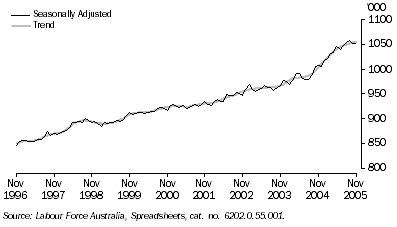
Industry employment
Growth in state employment was spread across most industries in Western Australia during the three months ending in November 2005. The industries contributing most to employment growth were Manufacturing (up 7,581 or 8.5%), Mining (up 5,065 or 10.6%), Government administration and defence (up 4,594 or 10.0%) and Accommodation, restaurants and cafes (up 4,589 or 11.7%). Growth in these industries, as well as in a number of others, were enough to offset the decline in five industries, including Retail (down 9,364 or 6.0%), Education (down 6,795 or 8.5%) and Electricity, gas and water supply (down 4,223 or 37.4%).
Unemployment
Unemployment in Western Australia fell dramatically in the three months to November 2005, with the number of unemployed persons decreasing by 10.8% (5,211 persons). This followed a substantial fall in the previous three month period of 8.0% (4,198 persons). The sharp and persistent decline in unemployed persons since mid-2005 has driven the state's unemployment rate to 3.9% in November 2005 - well below the national rate of 5.1% and the lowest level recorded since the current series began in 1978.
Unemployment rate
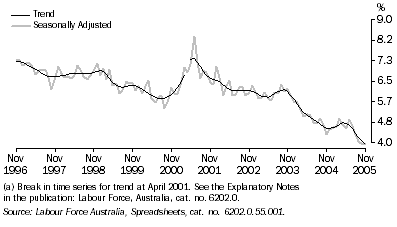
Participation
Participation in Western Australia's labour force weakened in the three months to November 2005, with 67.7% of the state's civilian population aged 15 years and over being either employed or actively seeking employment in November 2005, compared to 68.0% in August 2005. Together with the fall in unemployed persons, the decline in labour force participation has aided the fall in Western Australia's unemployment rate to a historically low level.
 Print Page
Print Page
 Print All
Print All